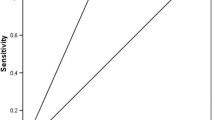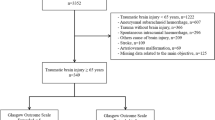Abstract
Objective
To assess the incidence and severity of nonneurological organ dysfunction and its effect on outcome in acute neurological patients in an international cohort observational study.
Design and setting
Analysis of database from the observational Sepsis Occurrence in Acutely Ill Patients (SOAP) study in 198 intensive care units (ICUs) in 24 European countries.
Patients
All adult patients admitted to the participating ICUs between 1 and 15 May 2002. Of the 3,147 patients in the SOAP database 373 (12%) were admitted with a neurological diagnosis, including 154 (41%) with traumatic brain injury and 186 (50%) with cerebrovascular accident.
Measurements and results
Patients were followed until death, hospital discharge, or for 60 days. Neurological patients were younger and had a higher incidence of trauma and fewer comorbidities than nonneurological patients. Neurological patients developed ICU-acquired sepsis and respiratory failure more frequently than the other patients. ICU and hospital mortality rates were higher and ICU length of stay longer in neurological than in nonneurological patients. Multivariate logistic analysis showed that, in addition to the Glasgow Coma Score (GCS) and the presence of nontraumatic brain injury, cardiovascular failure, hepatic failure, and ALI/ARDS were the only factors independently associated with a higher risk of death in the ICU in patients with a neurological diagnosis.
Conclusions
Although neurological patients were younger and had fewer comorbidities, they developed ICU-acquired sepsis and respiratory failure more frequently than other patients. Efforts should be oriented to reduce cardiovascular, hepatic, and respiratory complications.


Similar content being viewed by others
References
Marshall JC, Cook DJ, Christou NV, Bernard GR, Sprung CL, Sibbald WJ (1995) Multiple organ dysfunction score: a reliable descriptor of a complex clinical outcome. Crit Care Med 23:1638–1652
Holland MC, Mackersie RC, Morabito D, Campbell AR, Kivett VA, Patel R, Erickson VR, Pittet JF (2003) The development of acute lung injury is associated with worse neurologic outcome in patients with severe traumatic brain injury. J Trauma 55:106–111
Bratton SL, Davis RL (1997) Acute lung injury in isolated traumatic brain injury. Neurosurgery 40:707–712
Zygun DA, Kortbeek JB, Fick GH, Laupland KB, Doig CJ (2005) Non-neurologic organ dysfunction in severe traumatic brain injury. Crit Care Med 33:654–660
Gruber A, Reinprecht A, Illievich UM, Fitzgerald R, Dietrich W, Czech T, Richling B (1999) Extracerebral organ dysfunction and neurologic outcome after aneurysmal subarachnoid hemorrhage. Crit Care Med 27:505–514
Wartenberg KE, Schmidt JM, Claassen J, Temes RE, Frontera JA, Ostapkovich N, Parra A, Connolly ES, Mayer SA (2006) Impact of medical complications on outcome after subarachnoid hemorrhage. Crit Care Med 34:617–623
Contant CF, Valadka AB, Gopinath SP, Hannay HJ, Robertson CS (2001) Adult respiratory distress syndrome: a complication of induced hypertension after severe head injury. J Neurosurg 95:560–568
Rosenwasser RH, Jallo JI, Getch CC, Liebman KE (1995) Complications of Swan–Ganz catheterization for hemodynamic monitoring in patients with subarachnoid hemorrhage. Neurosurgery 37:872–875
Piek J, Chesnut RM, Marshall LF, Berkum-Clark M, Klauber MR, Blunt BA, Eisenberg HM, Jane JA, Marmarou A, Foulkes MA (1992) Extracranial complications of severe head injury. J Neurosurg 77:901–907
Solenski NJ, Haley EC Jr, Kassell NF, Kongable G, Germanson T, Truskowski L, Torner JC (1995) Medical complications of aneurysmal subarachnoid hemorrhage: a report of the multicenter, cooperative aneurysm study. Participants of the Multicenter Cooperative Aneurysm Study. Crit Care Med 23:1007–1017
Vincent JL, Sakr Y, Sprung CL, Ranieri VM, Reinhart K, Gerlach H, Moreno R, Carlet J, Le Gall JR, Payen D (2006) Sepsis in European intensive care units: results of the SOAP study. Crit Care Med 34:344–353
Le Gall J-R, Lemeshow S, Saulnier F (1993) A new simplified acute physiology score (SAPS II) based on a European/North American multicenter study. JAMA 270:2957–2963
Vincent JL, de Mendonça A, Cantraine F, Moreno R, Takala J, Suter P, Sprung C, Colardyn FC, Blecher S (1998) Use of the SOFA score to assess the incidence of organ dysfunction/failure in intensive care units: results of a multicentric, prospective study. Crit Care Med 26:1793–1800
Teasdale G, Jennett B (1974) Assessment of coma and impaired consciousness: a practical scale. Lancet II:81–84
ACCP-SCCM Consensus Conference (1992) Definitions of sepsis and multiple organ failure and guidelines for the use of innovative therapies in sepsis. Crit Care Med 20:864–874
Bernard GR, Artigas A, Brigham KL, Carlet J, Falke K, Hudson L, Lamy M, LeGall JR, Morris A, Spragg R (1994) The American–European Consensus Conference on ARDS. Definitions, mechanisms, relevant outcomes, and clinical trial coordination. Am J Respir Crit Care Med 149:818–824
Ott L, McClain CJ, Gillespie M, Young B (1994) Cytokines and metabolic dysfunction after severe head injury. J Neurotrauma 11:447–472
McKeating EG, Andrews PJ, Signorini DF, Mascia L (1997) Transcranial cytokine gradients in patients requiring intensive care after acute brain injury. Br J Anaesth 78:520–523
Kikuchi T, Okuda Y, Kaito N, Abe T (1995) Cytokine production in cerebrospinal fluid after subarachnoid haemorrhage. Neurol Res 17:106–108
Tracey KJ (2007) Physiology and immunology of the cholinergic antiinflammatory pathway. J Clin Invest 117:289–296
Robertson CS, Valadka AB, Hannay HJ, Contant CF, Gopinath SP, Cormio M, Uzura M, Grossman RG (1999) Prevention of secondary ischemic insults after severe head injury. Crit Care Med 27:2086–2095
Clifton GL, Miller ER, Choi SC, Levin HS (2002) Fluid thresholds and outcome from severe brain injury. Crit Care Med 30:739–745
Brain Trauma Foundation, American Association of Neurological Surgeons, Joint Section on Neurotrauma and Critical Care (1996) Guidelines for the management of severe head injury. J Neurotrauma 13:641–734
Lennihan L, Mayer SA, Fink ME, Beckford A, Paik MC, Zhang H, Wu YC, Klebanoff LM, Raps EC, Solomon RA (2000) Effect of hypervolemic therapy on cerebral blood flow after subarachnoid hemorrhage: a randomized controlled trial. Stroke 31:383–391
Touho H, Karasawa J, Shishido H, Yamada K, Yamazaki Y (1989) Neurogenic pulmonary edema in the acute stage of hemorrhagic cerebrovascular disease. Neurosurgery 25:762–768
Rogers FB, Shackford SR, Trevisani GT, Davis JW, Mackersie RC, Hoyt DB (1995) Neurogenic pulmonary edema in fatal and nonfatal head injuries. J Trauma 39:860–866
Chen HI (1995) Hemodynamic mechanisms of neurogenic pulmonary edema. Biol Signals 4:186–192
Yildirim E, Kaptanoglu E, Ozisik K, Beskonakli E, Okutan O, Sargon MF, Kilinc K, Sakinci U (2004) Ultrastructural changes in pneumocyte type II cells following traumatic brain injury in rats. Eur J Cardiothorac Surg 25:523–529
Brienza N, Dalfino L, Cinnella G, Diele C, Bruno F, Fiore T (2006) Jaundice in critical illness: promoting factors of a concealed reality. Intensive Care Med 32:267–274
Harbrecht BG, Zenati MS, Doyle HR, McMichael J, Townsend RN, Clancy KD, Peitzman AB (2002) Hepatic dysfunction increases length of stay and risk of death after injury. J Trauma 53:517–523
International Study of Unruptured Intracranial Aneurysms Investigators (1998) Unruptured intracranial aneurysms-risk of rupture and risks of surgical intervention. N Engl J Med 339:1725–1733
Author information
Authors and Affiliations
Consortia
Corresponding author
Rights and permissions
About this article
Cite this article
Mascia, L., Sakr, Y., Pasero, D. et al. Extracranial complications in patients with acute brain injury: a post-hoc analysis of the SOAP study. Intensive Care Med 34, 720–727 (2008). https://doi.org/10.1007/s00134-007-0974-7
Received:
Accepted:
Published:
Issue Date:
DOI: https://doi.org/10.1007/s00134-007-0974-7




